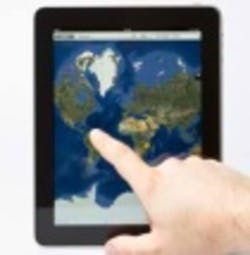In late August, researchers in the Global Institute for Emerging Healthcare Practices at the Falls Church, Va.-based CSC, released a new white paper entitled “Harnessing the Value of mHealth For Your Organization,” which looked at the proliferation of next-generation smart mobile devices, and the implications of mobile device adoption among physicians and other clinicians in U.S. patient care organizations.
In that report, Fran Turisco, research principal in the Waltham, Mass.-based Global Institute for Emerging Healthcare Practices, and Mike Garzone, chief technology officer for CSC’s U.S. Health Delivery Group, examine the recent acceleration in clinician adoption of mobile health (mHealth), and the challenges facing CIOs, CMIOs, and other healthcare IT leaders, as they react to an adoption curve that is in most organizations outstripping strategic planning for mobile health.
There are many aspects of this landscape of opportunity and challenge, and Turisco and Garzone delve into the broad range of implications involved. As they note, “Opportunities and challenges abound with mHealth and they are always increasing—enough to overwhelm many organizations. However, having completed the strategy and roadmap, ‘mHealth-ready’ organizations are equipped to tackle their highest project projects.” And as they emphasize, “[S]uccessful mHealth projects require much more than simply introducing new technology. There needs to be a program or process that incorporates the solution, and this can involve business and care processes, changing roles and responsibilities, and adding support services for device and application management and user support (Help Desk).”
Recently, HCI Editor-in-Chief Mark Hagland spoke with Fran Turisco regarding the report and its implications. Below are excerpts from that interview.
With regard to your report, how should the CIO, CMIO, vice-president-clinical informatics, and other healthcare IT leaders, be thinking strategically about the issues you and Mike Garzone illuminated?
I think the CIO needs to think about some of the big areas, as discussed in table 3 of our report (“Key mHealth Strategy Questions”). They need to ask, what do you want to do with mobility, and what is already being done with mobility? Are the doctors walking around already using the ePocrates dose calculator, or chatting with their patients via different apps? What are they using technology for already, and what do you see as your organization’s direction per mobility? One of the major elements under healthcare reform is all this stuff around the concept of accountable care—with small ‘a’ and small ‘c.’ And in terms of that broader concept of accountable care, it’s all about connecting the points of care, which fits in really well with the mobile health concept. And mobile health can be the preferred mode for expediting coordinated care.
So where is your organization moving in terms of this broad concept of accountable or coordinated care, and what’s already happening now in terms of devices? And iPads are the number-one device of choice right now. And you need to come up with an overall strategy; you need an overall program that encompasses governance and policies and procedures. For example, are you going to adopt a specific sanctioned platform? A lot of the apps work on Android and IOS. And are you going to prioritize requests?
Our feeling is that because what this offers is much more than technology—obviously, you’re building your governance and your support, and you’re deciding on what apps to use and how they’ll be used in the organization. And logically, you’ll want to begin by taking a project that picks off the low-hanging fruit. So if you’re concerned about Medicare patients being readmitted in 30 days, you set up a program to do address that issue. And that means there will be a technology component to it; there will be different workflows; and if you use an app, you’ll teach the patient to use the app; you’ll support the app, whether it’s used in the home or truly is mobile and is in the patient’s pocket—those kinds of things.
So we see organizations coming up with a mobility strategy, mobility governance, mobility infrastructure. And those different elements may be somewhat separate now, but they should ultimately be integrated. The typical situation we’re seeing involves a mixed picture. For example, we talked to the leaders at one particular hospital, and they had figured out which devices to allow, and had developed a policy around that. Their policy was that clinicians could bring in any devices they wanted, but that they had to hand each device to IT so the IT people could [implement encryption and security on that device].And they had developed a few apps, but they were all siloed, and weren’t connected yet to the clinical information system. They had a Citrix view into the clinical information system, but the mobile apps that they had created weren’t yet integrated into their clinical system. So for example, there might be a dose calculator or an image viewer—but the apps weren’t integrated into the overall clinical information suite.
And that’s where things are going. And that’s what the paper said, which is that these tools are cool and neat, but the longevity of use comes from the integration, so that summaries can be created for physicians and patients, for example. So that’s where we’re at right now, is that we’ve got thousands of apps doing different things—but those apps have to be integrated into core clinical information system development for truly accountable care and sustainability of use.
Given that the physicians in particular are bringing devices in and dragging senior IT leadership forward, doesn’t that mean CIOs and CMIOs really need to develop strategic plans around mobility, and quickly?
Yes, and you don’t have forever to develop those plans; you need to do one in a three-or-four-month planning process. And you need to develop a vision, direction, and ground rules.
And if a patient care organization is going to develop its own apps, do you have any thoughts?
Yes, one of the things that’s important to understand is that the FDA [Food and Drug Administration] is putting out advice on the use of medical devices and what is a medical device. And so things like ultrasound apps that are mobile, those are all things that go for approval. And some apps may actually require FDA approval; so those are things to consider.
And many organizations are developing very cool applications, especially physicians and other clinicians.
Yes, that’s right. And the whole thing about mHealth is, it’s been around a long time. I actually did a research report back in 2001 for the California Health Care Foundation, and referenced that report in this white paper. For this report, we looked at those types of applications that really are making the most of the smart mobility platform. So the things that are listed in here, and the things we describe, are things like using the camera, the GPS, the video capability, the high-level processing, such as search engine capabilities; and now, this is all available to you on this little teeny device that you can stick into your pocket or purse.
And the vendors are creating software development kits (SDKs) for development. So for example, Apple has an SDK that helps you develop an application to run on their operating system; so it makes it easy. One statistic we cited, which is probably already out of date, is that there are 17,000 healthcare apps already being used; and it’s amazing to me that 43 percent of those are for clinicians.
And we tried to look at the organizations that are making the most of these applications. And we put interesting examples in the tables and in the ‘Case In Point’ section. The other thing I think that’s particularly interesting now compared to a decade ago is that mHealth now covers the whole spectrum of healthcare—wellness, care monitoring, clinical decision support; and it covers life sciences, population health, and health plans. So health plans are using mHealth to help people make the best choices. So it’s one of those technologies that’s not just for care delivery, but that covers everything. And smart people, whether it’s clinicians, engineers, whatever, are coming up with really clever ways of taking platforms, taking connectivity, and creating these solutions that I believe are making a big difference.
How would you summarize your advice to healthcare IT leaders?
I would say, do it quickly, involve all the stakeholder groups, make sure you cover all the bases, and get everyone onto the same page, and then off you go. And if you do that, you’re going to get it about 80 percent of it right. And then you go and do your first couple of projects, and then you go back and tighten things up. And the good thing about a lot of these projects is that you’re not going to be working on them for three years—you’ll be focused on specific issues like reducing readmissions or monitoring diabetics. It won’t be an “ENTERPRISE-WIDE CLINICAL INFORMATION SYSTEM IMPLEMENTATION,” in capital letters.



